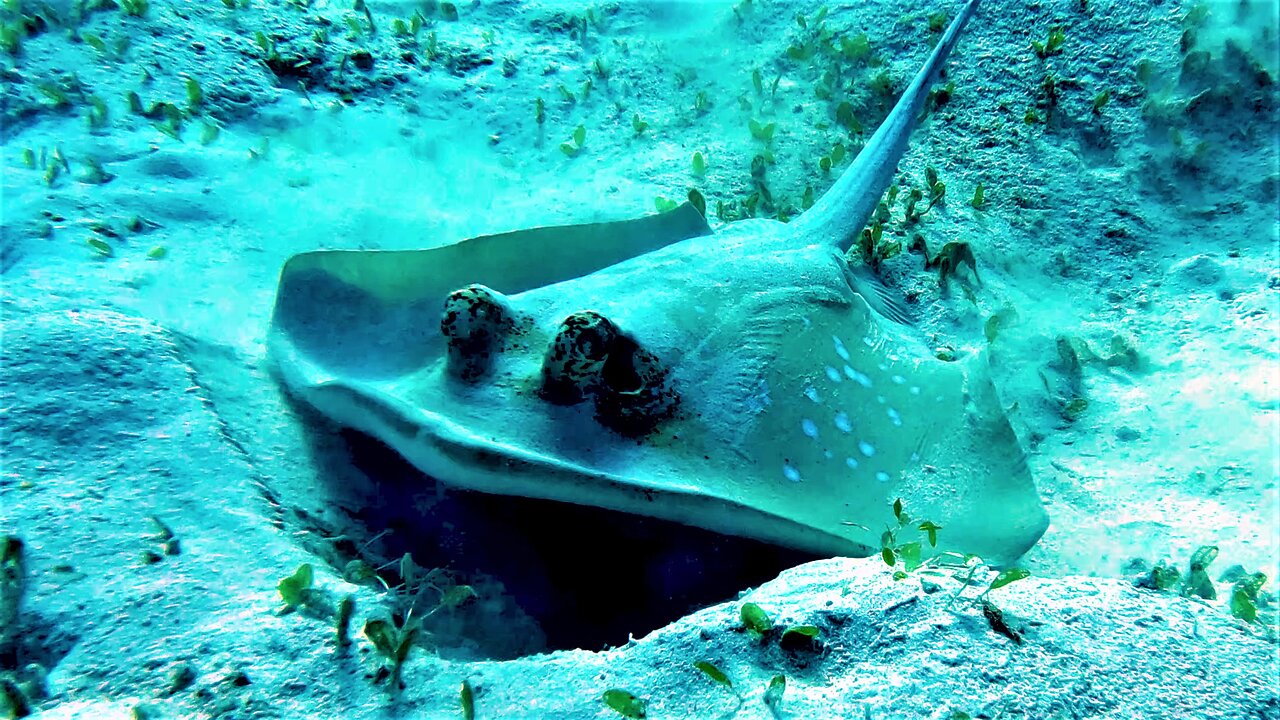Premium Only Content

Spotted ribbontail stingray eats animals hidden in the sand
Stingrays are highly intelligent and well adapted animals that live in most oceans around the world. They are beautiful to watch in motion as they glide along the ocean floor. Their flattened bodies are perfect for allowing them to skim over sand and debris, hunting for crustaceans, fish, and mollusks buried beneath. Their wings are used to beat the sand to uncover the animals, allowing them to be sucked into the stingray's mouth for consumption. A stingray's snout has pores filled with a gelatinous substance that detects the electrical impulses of prey, even those hidden or buried under solid material.
The jaws of the stingray are powerful, with flattened teeth that can crush shells to eat the animals sheltered within. Prey is inhaled into the mouth, crushed and swallowed. The sand and shells are expelled and the stingray moves on to the next meal.
The stingray has a special adaptation for breathing as well. It inhales water, but not through its mouth. It has spiracles located behind the eyes, through which water is sucked in, forced over the gills and expelled. This makes it possible for the stingray to breath, even when its body is buried in sand. The spiracles and eyes remain uncovered as the stingray benefits from the camouflage of a sanding covering.
As with many of the ocean's animals, a special adaptation creates a defense from predators. In most species of stingray, the tail is equipped with 1-3 sharp barbs. If a stingray is threatened or is stepped on, the barb can deliver a painful injury. The barbs often break off and remain in the wound. Although the wound itself is rarely fatal, the barb also has a venom that causes pain, and slows blood circulation. Stingrays are not aggressive and will very rarely attack humans or other animals, but accidents due to being accidentally stepped on in areas with swimmers are one of the leading causes of injuries from fish.
The stingray is a fish, and part of the shark family. They are cartilaginous, meaning that they don't have bones. Stingrays have the highest ratio of brain size to body mass of any fish and are thought to be the smartest of the fish. They demonstrate and ability to remember, learn, and communicate which exceeds what was previously believed.
Stingrays are still very mysterious creatures and we don't yet understand them fully. As we gain understanding of their roles in the health of the ocean and our planet, we will also gain insight that will help us protect them for the future.
-
 2:11
2:11
WildCreatures
10 days ago $1.23 earnedBrilliant Blue Hyacinth Macaw Eats Nuts With Impressive Dexterity
16.3K16 -
 LIVE
LIVE
Badlands Media
11 hours agoDEFCON ZERQ Ep. 007
8,114 watching -
 LIVE
LIVE
FreshandFit
2 hours agoOwen Shroyer leaves Alex Jones But Here's the Truth!
1,274 watching -
 2:04:10
2:04:10
Inverted World Live
7 hours agoJapanese Memory Eraser | Ep. 101
67.9K17 -
 2:42:52
2:42:52
TimcastIRL
5 hours agoTrump To Deploy National Guard To Chicago, Baltimore, Democrats Call To Resist | Timcast IRL
202K53 -
 3:22:30
3:22:30
Laura Loomer
6 hours agoEP141: Muslims Call For Political Assassinations At Michigan Palestinian Conference
31.6K24 -
 4:39:32
4:39:32
Barry Cunningham
7 hours agoBREAKING NEWS: PRESIDENT TRUMP IS GOING TO TAKE CHICAGO! LFG!!! (IT'S MOVIE NIGHT!)
79.8K54 -
 1:23:59
1:23:59
Man in America
9 hours agoTrump Demands Big Pharma Come Clean on Covid Shots w/ Dr. David Martin
34K25 -
 1:40:27
1:40:27
megimu32
4 hours agoOTS: Labor Day Sitcom Blowout - Tim, Ray, & Relatable Chaos!
30K4 -
 4:09:30
4:09:30
StevieTLIVE
5 hours agoWarzone Wins w/ FL Mullet Man
24.5K1